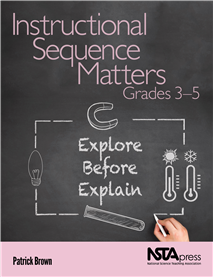All Book Chapters
Book Chapter
This chapter provides guidance on how you can create 5Es that translate the Next Generation Science Standards (NGSS). Activities are presented following each factor that you should consider when planning 5Es and offer some planning ideas to design �...
Book Chapter
Teaching About Heat and Temperature Using an Investigative Demonstration
Chapters 6–13 share grades 3–5 model lessons for putting the “explore-before-explain” mind-set into practice. This chapter can be used as a starting point for eliciting elementary teachers’ views of the effective sequencing of science instr...
Book Chapter
Investigating Change Using the Invisible Test Tube Demonstration
Chapters 6–13 share grades 3–5 model lessons for putting the “explore-before-explain” mind-set into practice. In this chapter, the model lesson is aimed at explaining why objects appear different underwater versus out in the open. The lesson ...
Book Chapter
There’s More to Magnetism Than Objects Being Attracted to Refrigerators
Chapters 6–13 share grades 3–5 model lessons for putting the “explore-before-explain” mind-set into practice. This chapter explores a phenomenon related to the lesson title and begins with an engagement activity that uses formative assessment...
Book Chapter
Making the Connections: Addressing Students’ Misconceptions of Circuits
Chapters 6–13 share grades 3–5 model lessons for putting the “explore-before-explain” mind-set into practice. In this chapter, elementary students explore phenomena related to understanding the question “Why do the lights turn on when we fl...
Book Chapter
Chapters 6–13 share grades 3–5 model lessons for putting the “explore-before-explain” mind-set into practice. This chapter offers a 5E lesson with Elaborate and Evaluate phases that places students in the role of scientist and asks them to ca...
Book Chapter
Chapters 6–13 share grades 3–5 model lessons for putting the “explore-before-explain” mind-set into practice. This lesson is one step in helping students develop an understanding of the conservation of matter that takes place during a chemica...
Book Chapter
A Natural Storyline for Learning About Ecosystems
Chapters 6–13 share grades 3–5 model lessons for putting the “explore-before-explain” mind-set into practice. In this chapter, the third-grade lesson is aimed at developing students’ ideas about living things and Earth’s systems. The less...
Book Chapter
The Grand Erosion Investigation
Chapters 6–13 share grades 3–5 model lessons for putting the “explore-before-explain” mind-set into practice. In this chapter, the fourth-grade lesson is aimed at helping students explore the Next Generation Science Standards (NGSS) performan...
Book Chapter
Leadership and Lessons Learned
This chapter takes you through five key points for putting an “explore-before-explain” mind-set into practice using Predict, Observe, and Explain (POE) and 5E sequences, as well as the Next Generation Science Standards (NGSS). This final chapter...
Book Chapter
Science and Religion as Part of Our Professional Responsibilities
In this first chapter, we make the argument that addressing science and religion is, in fact, part of our collective job. We review four domains of science teaching to make our case and to assist you in explaining, justifying, and defending your choi...
Book Chapter
The Need for History and Evolution as a Science-Religion Case Study
This chapter begins with introducing Ian Barbour, who is generally credited with establishing science-religion interactions as a historical discipline and providing a clear set of categories that serves as a useful starting point for discussing scien...
Book Chapter
The Arc of History Bends Toward Teaching Evolution
This chapter emphasizes the historical roots and persistence of opposition to evolution given that it is the most prevalent science-religion theme. Teaching evolution has presented a challenge to teachers since the 1920s. Even those who teach it enth...
Book Chapter
As you consider your current approach to teaching topics at the intersection of science and religion, we hope you’ll consider both the legal parameters and the extent to which you can engage all students. This chapter focuses on the legality of add...
Book Chapter
The research on the Creation Museum informed the focus of this chapter for providing teachers a broader context of the public’s varying attitudes, beliefs, and levels of trust in science and religion. In this chapter, the discussion is informed by ...



